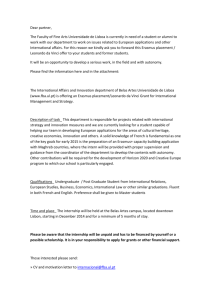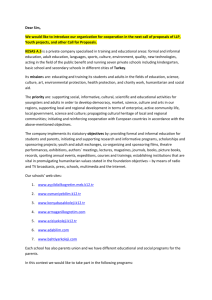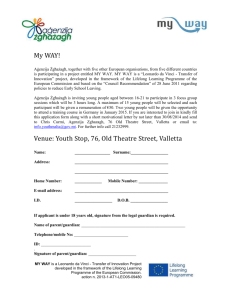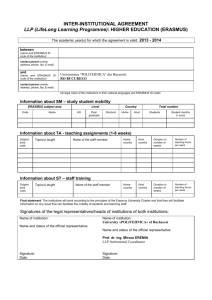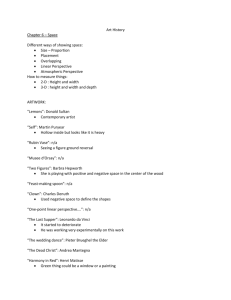LLP Programme
advertisement
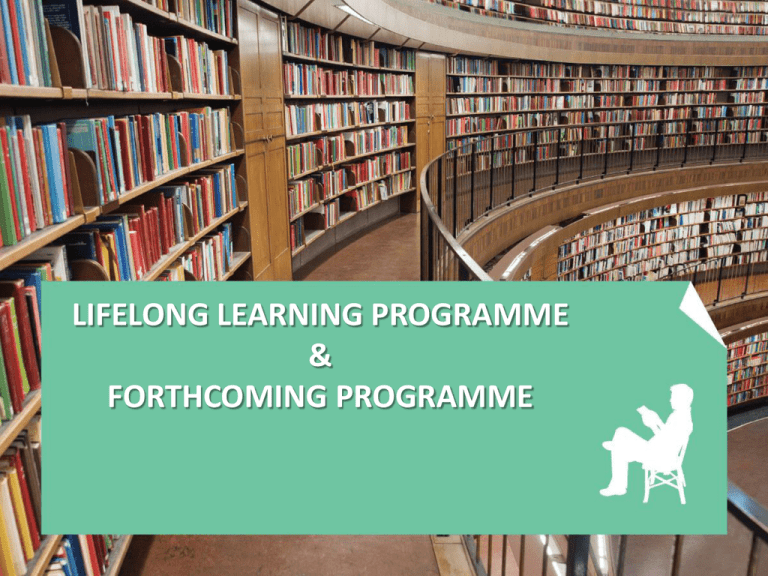
LIFELONG LEARNING PROGRAMME & FORTHCOMING PROGRAMME Lifelong Learning Programme (LLP) European Parliament and European Council No. 1720/2006/ES for period 2007–2013 Main target groups: individuals (pupils, students, teachers, lectorers, administrative support, managers – from educational sector) organizations (schools, organizations working in educational sector, labour offices, etc.) 33 participating countries (28 EU member states + Norway, Iceland, Lichtenstein, Turkey and Switzerland) Lifelong Learning Programme (LLP) 2007–2013 Comenius school education Leonardo da Vinci Erasmus vocational education and traning higher education Grundtvig adult education Transversal programme European language label Study visits for experts and decision-makers in education and training Jean Monnet stimulation of teaching, research and reflection in the field of European integration studies at the level of HEI within and outside of the EU 33 participating countries (28 EU member states + Norway, Iceland, Lichtenstein, Turkey, Switzerland) •3 COMENIUS – What are (were) the aims? • The Comenius programme focuses on the first phase of education, from pre-school and primary to secondary schools. It is relevant for all members of the education community: pupils, teachers, local authorities, parents’ associations, non-government organisations, teacher training institutes, universities and all other educational staff. 4 COMENIUS – What are (were) the aims? Specific objectives •To develop knowledge and understanding among young people and educational staff of the diversity of European cultures and languages and its value •To help young people acquire the basic life-skills and competences necessary for their personal development, for future employment and for active European citizenship Operational objectives •To improve the quality and to increase the volume of mobility involving pupils and educational staff in different Member States •To improve the quality and to increase the volume of partnerships between schools in different Member States, so as to involve at least 3 million pupils in joint educational activities during the period of the programme •To encourage the learning of modern foreign languages •To support the development of innovative ICT-based content, services, pedagogies and practice in lifelong learning •To enhance the quality and European dimension of teacher training •To support improvements in pedagogical approaches and school management 5 COMENIUS – What are COMENIUS actions? • • • • • • • • • • • • COMENIUS Preparatory Visits COMENIUS Assistantships (ASSISTANTS) COMENIUS Assistantships (HOST SCHOOLS) COMENIUS Individual Pupil Mobility COMENIUS In-Service Training for Teachers and other Educational Staff (IST) COMENIUS Multilateral school partnerships COMENIUS Bilateral school partnerships COMENIUS Regio Partnerships COMENIUS Multilateral projects COMENIUS Multilateral networks COMENIUS Accompanying measures eTwinning 6 ERASMUS – What are (were) the aims? Erasmus is the EU's education and training programme for mobility and cooperation in higher education across Europe. Its different actions not only address students wishing to study and work abroad, but also higher education teachers and enterprise staff intending to teach abroad and to higher education staff seeking training abroad. In addition, Erasmus supports higher education institutions to work together through intensive programmes, networks and multilateral projects as well as to reach out to the world of business. 7 ERASMUS – What are (were) the aims? Specific objectives •To support the achievement of a European Higher Education Area •To reinforce the contribution of higher education and advanced vocational education to the process of innovation. Operational objectives •To improve the quality and to increase the volume of students and teaching staff mobility throughout Europe, so as to contribute to the achievement by 2012 of at least 3 million individual participants in student mobility under the Erasmus and its predecessor programmes •To improve the quality and to increase the volume of multilateral cooperation between higher education institutions in Europe •To increase the degree of transparency and compatibility between higher education and advanced vocational education qualifications gained in Europe •To improve the quality and to increase the volume of cooperation between higher education institutions and enterprises •To facilitate the development of innovative practices in education and training at tertiary level, and their transfer, including from one participating country to others •To support the development of innovative ICT-based content, services, pedagogies and practice for lifelong learning 8 ERASMUS – What are ERASMUS Actions? • • • • • • • • • • • ERASMUS Preparatory Visits ERASMUS Organisation of Mobility ERASMUS Student Mobility for Studies ERASMUS Student Mobility for Placements ERASMUS Staff Mobility – Teaching Assignments by HEI Teaching Staff and by – Invited Staff from Enterprises ERASMUS Staff Mobility – Training for HEI Staff at Enterprises and at HEI ERASMUS Intensive Language Courses ERASMUS Intensive Programmes ERASMUS Academic Networks ERASMUS Multilateral Projects ERASMUS Accompanying Measures 9 9 LEONARDO da VINCI – What are (were) the aims? The Leonardo da Vinci programme links policy to practice in the field of vocational education and training (VET). Projects range from those giving individuals the chance to improve their competences, knowledge and skills through a period abroad, to Europe-wide co-operation between VET stakeholders in order to enhance the attractiveness, quality and performance of VET systems and practices. 10 LEONARDO da VINCI – What are (were) the aims? Specific objectives • • • To support participants in training and further training activities in the acquisition and the use of knowledge, skills and qualifications to facilitate personal development To support improvements in quality and innovation in vocational education and training systems, institutions and practices To enhance the attractiveness of vocational education and training and mobility for employers and individuals and to facilitate the mobility of working trainees Operational objectives • To improve the quality and to increase the volume of mobility throughout Europe of people • • • • • involved in initial vocational education and training and in continuing training, so as to increase placements in enterprises to at least 80.000 per year by the end of the LLP To improve the quality and to increase the volume of co-operation between institutions or organisations providing learning opportunities, enterprises, social partners and other relevant bodies throughout Europe To facilitate the development of innovative practices in the field of vocational education and training other than at tertiary level, and their transfer, including from one participating country to others To improve the transparency and recognition of qualifications and competences, including those acquired through non-formal and informal learning To encourage the learning of modern foreign languages To support the development of innovative ICT-based content, services, pedagogies and 11 practice for lifelong learning LEONARDO da VINCI – What are Leonardo da Vinci Actions? • • • • • • • • • LEONARDO DA VINCI Preparatory Visits LEONARDO DA VINCI IVT (Initial Vocational Training) LEONARDO DA VINCI PLM (People in the Labour Market) LEONARDO DA VINCI VETPRO (VET Professionals) LEONARDO DA VINCI Partnerships LEONARDO DA VINCI Transfer of innovation LEONARDO DA VINCI Development of innovation LEONARDO DA VINCI Networks LEONARDO DA VINCI Accompanying measures 12 GRUNDTVIG – What are (were) the aims? Addresses the teaching and learning needs relating to all forms of adult learning which are not of a predominantly vocational nature, as well as the institutions and organisations providing or facilitating any form of such learning opportunities for adults – whether of a formal, non-formal or informal nature – including those involved in the initial and in-service training of staff. 13 13 GRUNDTVIG – What are (were) the aims? Specific objectives • To respond to the educational challenge of an ageing population in Europe • To help provide adults with pathways to improving their knowledge and competences Operational objectives • To improve the quality and accessibility of mobility throughout Europe of people involved in adult education and to increase its volume, so as to support the mobility of at least 7.000 of such individuals per year by 2013 • To improve the quality and to increase the volume of co-operation between organisations involved in adult education throughout Europe • To assist people from vulnerable social groups and in marginal social contexts, in particular older people and those who have left education without basic qualifications, in order to give them alternative opportunities to access adult education • To facilitate the development of innovative practices in adult education and their transfer, including from one participating country to another • To support the development of innovative ICT-based content, services, pedagogies and practice for lifelong learning • To improve pedagogical approaches and the management of adult education organisations 14 14 GRUNDTVIG – What are GRUNDTVIG Actions? • • • • • • • • • • GRUNDTVIG Preparatory Visits GRUNDTVIG Visits and Exchanges for adult education staff GRUNDTVIG Assistantships GRUNDTVIG In-Service training for adult education staff GRUNDTVIG Workshops GRUNDTVIG Learning Partnerships GRUNDTVIG Senior Volunteering Projects GRUNDTVIG Multilateral projects GRUNDTVIG Multilateral networks GRUNDTVIG Accompanying measures 15 15 TRANSVERSAL PROGRAMME – What are (were) the aims? The transversal programmes aim to complement the sectorial sub programmes and to ensure that they achieve the best results possible. They aim to promote European cooperation in fields covering two or more of the sub-programmes. In addition they seek to promote quality and transparency of Member States' education and training systems. Four key activities focus on: • Policy cooperation and innovation • Languages • Information and communication technologies - ICT • Dissemination and exploitation of results 16 The future… GRUNDTVIG: LIBRARIES Key figures (2014–2020) Erasmus + Overall budget €19 billion (includes €1.8 billion for international cooperation) Overall mobility opportunities 5 million people Higher education 2.2 million students Staff mobility 1 million teachers, trainers, youth workers and other staff Vocational education and training 735 000 students Volunteer and youth exchange schemes 540 000 young people Master's degree loan guarantee scheme 330 000 students International students 135 000 students Joint degree grants 34 000 students Cooperation targets: Strategic Partnerships More than 20 000 linking together 115 000 institutions Knowledge Alliances 200 set up by 2000 higher education institutions and businesses Sectoral Skills Alliances 200 set up by 2000 education and training providers and businesses Thank you for your attention! LLP: http://ec.europa.eu/education/lifelong-learning-programme Erasmus+: http://ec.europa.eu/education/erasmus-for-all

